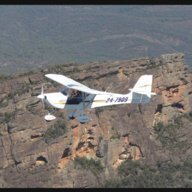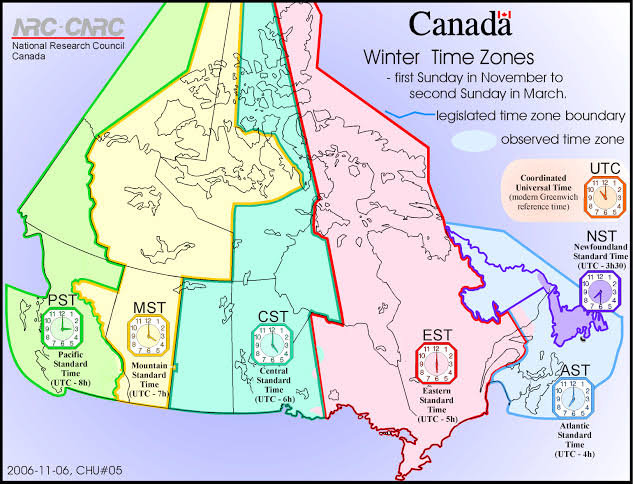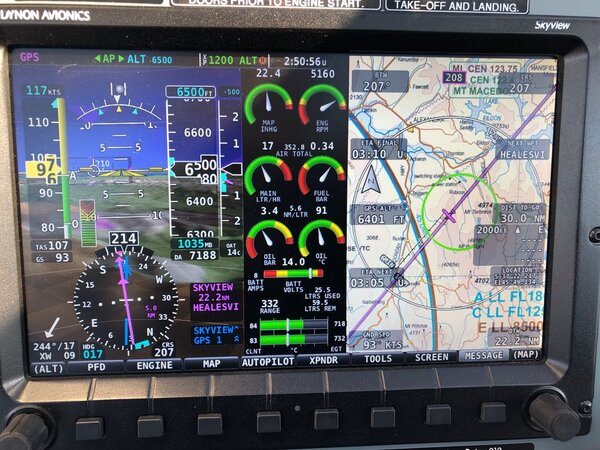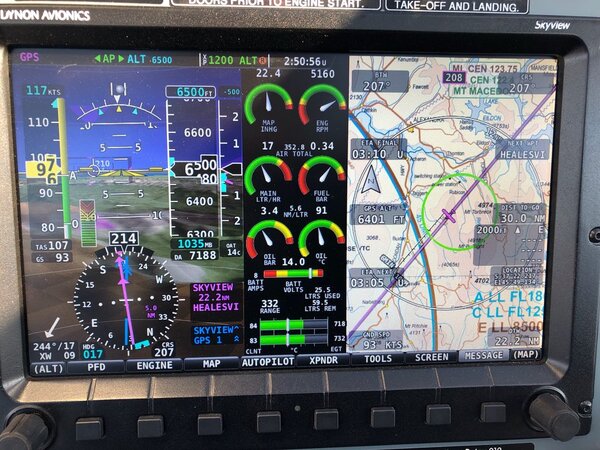-
Posts
493 -
Joined
-
Last visited
-
Days Won
4
Content Type
Profiles
Forums
Gallery
Downloads
Blogs
Events
Store
Aircraft
Resources
Tutorials
Articles
Classifieds
Movies
Books
Community Map
Quizzes
Posts posted by dsam
-
-
Terribly sad incident. Condolences to the families of the deceased. Answers must be found, and lessons learned.
-
Having actually gone "Inadvertent IMC" in a helicopter at low level / speed (its called dust and heavy aircraft) its bloody hard work even when you have briefed what you are going to do if it happens, you are very current at it, have a full set of instruments and a co-pilot to help you out.. I can only imagine how hard it is when it happens unplanned / un-briefed you are on your own in the cockpit and you have to transition to instruments instantly!
Agreed. I’ve experienced blinding dusty conditions as a passenger in a heavy helicopter departing from Karratha some years ago. I’ve also driven through the USA crash area, and that sort of dust obliteration doesn’t really happen there, particularly on rapid decent from cruise altitudes (aka CFIT). The decision to stay on the ground IMHO should have been made at the outset.
-
I think I read that:
- the pilot was IFR trained, but not current.
- the aircraft was not IFR equipped
- the flight was initially conducted as VFR, with requested special VFR
- the crash site was in IMC at the time and place of impact.
As pilot in command, you would have authority to tell PotUS you can’t and won’t fly in IMC, so he’d better call for a taxi (granted, you‘d need a good backbone).
If my reading of the main points is accurate, I’m inclined to criticise the pilot’s failure to rightfully stay on the ground, as the chief cause of the deaths (Ie. poor airmanship by attempting the flight).
I suppose the NTSB official report will show whether my conjecture is accurate...
-
 2
2
-
-
I well remember the toughest time I said “no”. Family and friends gathered for a series of (much anticipated) local joy flights that were planned some days in advance. A strong, gusty crosswind steadily got worse shortly after I arrived.
I disappointed adults and kids alike when I made the call to tie-down for the day. I kept telling myself of my greater responsibility to my passengers - injuring somebody I loved felt unimaginable, and that strengthened my resolve to stay tied-down.
I’m certain I made the right choice saying no, that afternoon.
-
 4
4
-
 1
1
-
 1
1
-
-
I’ve never forgotten my student pilot days observing a glider (that I was meant to fly in next) try to stretch a final approach above a wire. Stall and cartwheel was the sad result. Luckily they survived, but I never forgot the lessons:
1) If you see a wire at the last moment, go under it.
2) Under 200 ft AGL on approaches, always expect a (previously unseen) wire.
3) Set up your final leg a bit high, and sideslip to steepen the glide angle when near the threshold - especially at unfamiliar fields (or do a precautionary flyover above 200 ft.).
-
Another part of Boeing’s remedy involves software changes to limit the envelope so less nose down jack-screw will be required! It’s becoming obvious that this re-vamp to an existing airframe has been a “dogs breakfast” from start to finish!
-
I heard that with the horizontal stabiliser jack-screw in full nose down, the forces are so strong that the manual trim wheels need to be forced back by both pilots whilst “porpoising” the control column forward to un-load those forces momentarily! Not really intuitive with the ground rushing up at you.
Of course pilots were meant to recognise the fault long before the jack screw gets to that extreme - sadly two crews didn’t. I believe that part of Boeing’s resolution of the problem will now limit the travel of the jack-screw into the nose down direction.
-
-
Here is an insightful analysis of the latest hearings:
-
 1
1
-
-
The Runway clearance lights before the threshold.
Yes, I deliberately posed my question as a hypothetical, - it wasn't intended to directly relate to the actual cause of this crash, just as a way for me to clarify what training & procedures are considered with EFATO in multi-engined aircraft. Facthunter was able to provide me with the answer I sought.
-
Yes a plane like this can fly well on 3 engines once it's cleaned up and trimmed out. Being cleaned up means the dud engine (if there was one) is feathered successfully, Flaps up, wheels up and the cowl gills etc closed. IF an engine can't be feathered due some condition in the feathering system or the prop has fined off and really creating drag all bets are off regarding ability to continue flying.. Most of these Big round engines have fire extinguishing systems that are reasonably effective. One would have though there would be some "filming" of the plane in flight, but perhaps not. Sad outcome for all affected and it ended up some distance from the runway and hitting something heavy and solid quite hard. Nev
Hypothetical question for multi-engine pilots - I'm certainly not one ?. I accept that EFATO often leads to dangerous asymmetrical thrust, quite possibly beyond rudder control to correct it at low airspeed while attempting to climb.
Does it ever get recommended that in this scenario, the best option might be to reduce thrust from good engine(s) to minimise asymmetry effects, and stabilise for a (possibly inevitable) off-field forced landing with much-improved controllability/survivability. Granted, reducing power from a good engine is counter-intuitive, but you might just manipulate things to get a better outcome... just some musings from a former glider pilot that practiced winch-break exercises....
-
“Wrong Way” Corrigan probably demonstrated a wilful disregard for regulatory authority and adventuresome spirit that many lament about today:
-
 1
1
-
-
It’s not exactly a time zone issue, but early Canadian bush pilots had very short daylight hours, long inhospitable distances, high winds & blizzards, whiteout weather, as well as large & rapidly changing magnetic variation to account for when navigating the north. Not for the faint hearted.
-
 1
1
-
-
Spare a thought for Canada with 6 time zones! Being close to the geographic North Pole, the lines of longitude narrow considerably, especially in the arctic regions. The north magnetic pole is actually wandering about within Canadian territory - just to add to the navigational complexity. Northern bush pilots really have their work cut out for them!
https://www.nature.com/articles/d41586-019-00007-1
-
 1
1
-
-
...until GPS goes down.
Keep that paper map handy.
The GPS and Glonass systems would both have to go down simultaneously (most unlikely). Perhaps a massive solar event might do that, taking all communication satellites out at the same time - a massive global disruption!
My displayed maps wouldn’t “vanish”. They’d stop moving at my last ‘fix’ and I’d be immediately alerted by my devices of loss of satellites. I remain free to use my displayed maps to consider my intentions for landing - along with the rest of the worldwide aviation fleet!
-
 3
3
-
 1
1
-
-
I always have a paper map with track drawn on it, and a paper printout of the flight plan.
my only gripe with Ozrunways is that it will not print out the plan without heading and times so that you can print it days before and then write the details in when you have downloaded wind and chosen altitude.
OzRunways does allow the printing of blank lines on the plan sheet as you refer. With the plan sheet displayed, hit the printer icon and look for “Add Blank Lines” tick-box
-
 1
1
-
-
Do you who use Oz-Runways have a track on a map in case your iPad dies?
Yes, I print a map of my track from OzRunways, along with flight & fuel plan, W&B, ERSA aerodrome pages, etc. These days I never need them though...
I’m an older guy (PPL in 1974) that has enthusiastically embraced everything modern. My panel has a 10” Dynon Skyview with 1 hour battery backup. The panel has another Garmin gps + map with battery backup. Either gps can drive the autopilot. I fly with 2 iPads and 1phone, all with OzRunways, and AvPlan.
Having this many backup devices & software renders old-school ways of steam gauges and whizz-wheels to history in my experience. I’d never go back to that, given a choice... and these days it’s an obvious and easy choice with redundancy of devices.
-
 1
1
-
 2
2
-
-
I guess everyone knows OzRunways will calculate LL and you can put it up to display along with GS, Track, Brng To, and ETA?
Quite right Kaz. Let’s not forget that OzRunways and AvPlan are, in the first instance flight planning tools, not TSO’d glass panels. My early ground-schools always emphasised “plan the flight - then fly the plan”. The software makes comprehensive plans much quicker to create than in the old days, and that most certainly includes departure times, ETE, ETA, LL information.
If a pilot strays well away from a planned departure time & track to sightsee, that pilot is not flying the plan! Prudent airmanship requires re-doing the new flightplan - not a particularly arduous task with modern planning software at one’s fingertips.
One additional generalised point - my sincere condolences to the family and friends of the deceased. This entire thread (which I have also posted to) has made considerable comment and speculation that has not yet been a formal finding of the coroner. Much of this discussion is a worthwhile learning exercise, but perhaps out of respect to the families of the deceased, and respecting court processes, we should start a new threaded discussion.
-
 1
1
-
 1
1
-
-
Here is an example display from my Dynon Skyview. It drives the autopilot, can utilise a second backup gps source, and the integrated battery backup is 1 hour following aircraft power failure. It receives my flightplan updates directly via wifi from my iPad with OzRunways or AvPlan. Moving Airservices maps are also regularly updated from either EFB, along with approach plates etc.
Situational awareness is plentiful, along with glide ring (offset for calculated winds aloft). Angle of Attack indication is via the Dynon pitot. Calculated range, and “time at destination” info is always updating during flight. Virtual “six pack” display is readily available if one prefers. I couldn’t ask for more in my Eurofox.
-
 1
1
-
-
My extra 2 cents worth in addition to the excellent content by mnewbery:
I also operate with OzRunways on my iPad, and AvPlan on my iPhone. Both are on the Telstra network for best outback coverage. That way my position and track are usually visible to pilots with the majority of EFB’s in Australia, and vice versa.
My Raspberry Pi ADSB-in cost me $120 in components to directly see ADSB traffic on my iPad. I can be seen with my ADSB-out transponder. I also have a PLB and Spot tracking device for “worst case” outback scenarios.
Regardless, keep your eyes scanning outside the cockpit. Not everything is electronic, and don’t forget about bird strikes!
Happy flying...
-
 2
2
-
-
Yes, I for one have appreciated Nev’s thoughtful comments over the years - much appreciated Facthunter!

-
These days, one could use AoA audible alarms. The Dynon Skyview pitot tube system does a fine job alerting me in my headset, whilst my eyes are scanning outside the cockpit. No need for graphs, flight envelope calculations... you don’t even need to see your ASI!
-
 1
1
-
 1
1
-
-
My first time in an aircraft was in a RCAF DC3 in 1969, as an Air Cadet. They did some gentle stalls during our familiarisation flight, and I was hooked for life! That DC3 experience is unforgettable for me.
Distractions can be deadly in any aircraft, regardless of size and complexity - at all times, never forget to “fly the damn airplane”! That includes the after-touchdown rollout & taxi, particularly in lightweight recreational aircraft with gusty crosswind conditions.
-
 2
2
-
-
Here is a (somewhat lengthy) article that addresses many of the 737 Max issues touched on by many forum members in this thread. It is aimed at a more general audience than an aviation community, but still addresses the main foci of criticism in this tragic event.








Mangalore incident today (19/2/2020)
in Aircraft Incidents and Accidents
Posted
My ADSB-in (raspberry pi) device also made me look outside keenly in exactly the right direction. Often, in good VFR with my 20/20 vision I still couldn’t see the oncoming “paint” aircraft until the last 15 seconds, (thankfully with good spacing each time). I believe pilots often overestimate their visual capabilities, and oncoming speeds leave little time for evasive action. I’m a big advocate for flarm and ADSB-in traffic awareness systems.